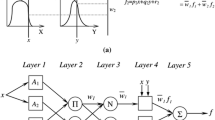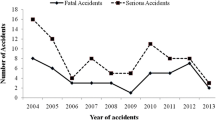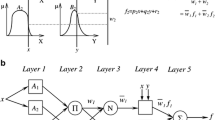Abstract
Flyrock arising from blasting operations is one of the crucial and complex problems in mining industry and its prediction plays an important role in the minimization of related hazards. In past years, various empirical methods were developed for the prediction of flyrock distance using statistical analysis techniques, which have very low predictive capacity. Artificial intelligence (AI) techniques are now being used as alternate statistical techniques. In this paper, two predictive models were developed by using AI techniques to predict flyrock distance in Sungun copper mine of Iran. One of the models employed artificial neural network (ANN), and another, fuzzy logic. The results showed that both models were useful and efficient whereas the fuzzy model exhibited high performance than ANN model for predicting flyrock distance. The performance of the models showed that the AI is a good tool for minimizing the uncertainties in the blasting operations.







Similar content being viewed by others
References
Acaroglu O (2011) Prediction of thrust and torque requirements of TBMs with fuzzy logic models. Tunn Undergr Space Technol 26:267–275
Adhikari GR (1999) Studies on flyrock at limestone quarries. Int J Rock Mech Rock Eng 32:291–301
Aghajani-Bazzazi A, Osanloo M, Azimi Y (2009) Flyrock prediction by multiple regression analysis in Esfordi phosphate mine of Iran. Proceedings of the 9th international symposium on rock fragmentation by blasting, Granada, Spain, pp 649–657
Amini H, Gholami R, Monjezi M, Torabi SR, Zadhesh J (2011) Evaluation of flyrock phenomenon due to blasting operation by support vector machine. Neural Comput Appl. doi:10.1007/s00521-011-0631-5
Aydin A (2004) Fuzzy set approaches to classification of rock masses. Eng Geol 74:227–245
Bajpayee TS, Rehak TR, Mowrey GL, Ingram DK (2004) Blasting injuries in surface mining with emphasis on flyrock and blast area security. Safety Res 35:47–57
Baliktsis E, Baliktsis A (2004) Flyrock risk prevention—from theory and ideas to a perfectly applied blasting project. Proceedings of the 1st international conference on advances in mineral resources management and environmental geotechnology, Hania, Greece, pp 17–23
Bhandari S (1997) Engineering rock blasting operations. A.A Balkema, Rotterdam
Fisne A, Kuzu C, Hudaverdi T (2010) Prediction of environmental impacts of quarry blasting operation using fuzzy logic. Environ Monit Assess 174:461–470
Fletcher LR, D’Andrea DV (1986) Control of flyrock in blasting. Proceedings of the 12th conference on explosives and blasting technique, Atlanta, Georgia, pp 167–177
Ghasemi E, Ataei M (2012) Application of fuzzy logic for predicting roof fall rate in coal mines. Neural Comput Appl. doi:10.1007/s00521-012-0819-3
Ghasemi E, Sari M, Ataei M (2012a) Development of an empirical model for predicting the effects of controllable blasting parameters on flyrock distance in surface mines. Int J Rock Mech Min Sci 52:163–170
Ghasemi E, Ataei M, Hashemolhosseini H (2012b) Development of a fuzzy model for predicting ground vibration caused by rock blasting in surface mining. J Vib Control. doi:10.1177/1077546312437002
Gokceoglu C (2002) A fuzzy triangular chart to predict the uniaxial compressive strength of Ankara agglomerates from their petrographic composition. Eng Geol 66:39–51
Gokceoglu C, Zorlu K (2004) A fuzzy model to predict the uniaxial compressive strength and the modulus of elasticity of a problematic rock. Eng Appl Artif Intell 17:61–72
Grima MA, Babuska R (1999) Fuzzy model for the prediction of unconfined compressive strength of rock samples. Int J Rock Mech Mining Sci 36:339–349
Grima MA, Bruines PA, Verhoef PNW (2000) Modelling tunnel boring machine performance by neuro-fuzzy methods. Tunn Undergr Space Technol 15:259–269
Haykin S (1994) Neural networks a comprehensive foundation. Macmillan, New York
Institute of Makers of Explosives (IME) (1997) Glossary of commercial explosives industry terms. Safety publication, No. 12, Institute of Makers of Explosives, Washington
Jang JR (1993) ANFIS: adaptive-network-based fuzzy inference system. IEEE Trans Syst, Man, Cybern 23:665–685
Kahraman S, Altun H, Tezekici BS, Fener M (2006) Sawability prediction of carbonate rocks from shear strength parameters using artificial neural networks. Int J Rock Mech Min Sci 43:157–164
Karacan CO (2008) Modeling and prediction of ventilation methane emissions of U.S. longwall mines using supervised artificial neural networks. Int J Coal Geol 73:371–387
Kecojevic V, Radomsky M (2005) Flyrock phenomena and area security in blasting-related accidents. Saf Sci 43:739–750
Khademi Hamidi J, Shahriar K, Rezai B, Bejari H (2010) Application of fuzzy set theory to rock engineering classification systems: an illustration of the rock mass excavability index. Rock Mech Rock Eng 43:335–350
Khandelwal M, Kumar DL, Yellishetty M (2009) Application of soft computing to predict blasting-induced ground vibration. Eng Comput. doi:10.1007/s00366-009-0157-y
Ladegaard-Pedersen A, Holmberg R (1973) The dependence of charge geometry on flyrock caused by crater effects in bench blasting. Swedish Detonic Research Foundation Report DS 1973
Li W, Li H (2009) Fuzzy system models (FSMs) for analysis of rock mass displacement caused by underground mining in soft rock strata. Expert Syst Appl 36:4637–4645
Little TN (2007) Flyrock risk. Proceedings EXPLO 2007, Wollongong, pp 35–43
Little TN, Blair DP (2009) Mechanistic Monte Carlo models for analysis of flyrock risk. Proceedings of the 9th international symposium on rock fragmentation by blasting. Granada, Spain, pp 641–647
Lundborg N (1974) The hazards of flyrock in rock blasting. Swedish Detonic Research Foundation, Reports DS 12
Lundborg N (1981) The probability of flyrock. Swedish Detonic Research Foundation Report DS 1981
Lundborg N, Persson A, Ladegaard-Pedersen A, Holmberg R (1975) Keeping the lid on flyrock in open-pit blasting. Eng Min J 176:95–100
Mamdani EH, Assilian S (1975) An experiment in linguistic synthesis with a fuzzy logic controller. International Journal of Man–machine. Studies 7:1–13
MATLAB 7.6 (2008) Software for technical computing and model-based design. The Math Works Incorporation
Mohamed MT (2009) Artificial neural network for prediction and control of blasting vibrations in Assiut (Egypt) limestone quarry. Int J Rock Mech Min Sci 46:426–431
Monjezi M, Dehghani H (2008) Evaluation of effect of blasting pattern parameters on backbreak using neural networks. Int J Rock Mech Min Sci 45:1446–1453
Monjezi M, Amini Khoshalan H, Yazdian Varjani A (2010a) Prediction of flyrock and backbreak in open pit blasting operation: a neuro-genetic approach. Arab J Geosci. doi:10.1007/s12517-010-0185-3
Monjezi M, Bahrami A, Yazdian Varjani A (2010b) Simultaneous prediction of fragmentation and flyrock in blasting operation using artificial neural networks. Int J Rock Mech Min Sci 47:476–480
Monjezi M, Rezaei M, Yazdian Varjani A (2010c) Prediction of backbreak in open-pit blasting using fuzzy set theory. Expert Syst Appl 37:2637–2643
Monjezi M, Amini Khoshalan H, Yazdian Varjani A (2011) Optimization of open pit blast parameters using genetic algorithm. Int J Rock Mech Min Sci 48:864–869
Persson P, Holmberg R, Lee J (1984) Rock blasting and explosives engineering. CRC Press, New York
Raina AK, Chakraborty AK, Choudhury PB, Sinha A (2010) Flyrock danger zone determination in opencast mines: a risk based approach. Bull Eng Geol Environ 70:163–172
Rehak TR, Bajpayee TS, Mowrey GL, Ingram DK (2001) Flyrock issues in blasting. Proceedings of the 27th annual conference on explosives and blasting technique, vol. I. International Society of Explosives Engineers, Cleveland, pp 165–175
Rezaei M, Monjezi M, Yazdian Varjani A (2011) Development of a fuzzy model to predict flyrock in surface mining. Saf Sci 49:298–305
Richards AB, Moore AJ (2004) Flyrock control—by chance or design. In: Proceedings of 30th ISEE conference on explosives and blasting technique, New Orleans, LA
Ross TJ (1995) Fuzzy logic with engineering applications. McGraw-Hill, New York
Roth J (1979) A model for the determination of flyrock range as a function of shot conditions. US Bureau of Mines contract J0387242, Management Science Associates, Los Altos
Simpson PK (1990) Artificial neural system-foundation, paradigm application and implementations. Pergamon Press, New York
Siskind DE, Kopp JW (1995) Blasting accidents in mines: a 16-year summary. Proceedings of the 21st annual conference on explosives and blasting technique. International society of Explosives Engineers, Cleveland, pp 224–239
St George JD, Gibson MFL (2001) Estimation of flyrock travel distances: a probabilistic approach. Proceedings EXPLO 2001, New South Wales, pp 245–248
Tzamos S, Sofianos AI (2006) Extending the Q system’s prediction of support in tunnels employing fuzzy logic and extra parameters. Int J Rock Mech Min Sci 43:938–949
Verakis HC, Lobb TE (2003) An analysis of surface coal mine blasting accidents. Preprint for SME 2003 Annual meeting, Littleton, Colorado, USA, Preprint No. 03–081
Verma AK, Singh TN (2010) Intelligent systems for ground vibration measurement: a comparative study. Eng Comput. doi:10.1007/s00366-010-0193-7
Workman JL, Calder PN (1994) Flyrock prediction and control in surface mine blasting. Proceedings of the 20th ISEE conference on explosives and blasting technique. Austin, Texas, pp 59–74
Yagiz S, Gokceoglu C (2010) Application of fuzzy inference system and nonlinear regression models for predicting rock brittleness. Expert Syst Appl 37:2265–2272
Yilmaz I, Kaynar O (2011) Multiple regression, ANN (RBF, MLP) and ANFIS models for prediction of swell potential of clayey soils. Expert Syst Appl 38:5958–5966
Yilmaz I, Yuksek AG (2008) An example of artificial neural network application for indirect estimation of rock parameters. Rock Mech Rock Eng 41:781–795
Zadeh LA (1965) Fuzzy sets. Inf Control 8:338–353
Author information
Authors and Affiliations
Corresponding author
Rights and permissions
About this article
Cite this article
Ghasemi, E., Amini, H., Ataei, M. et al. Application of artificial intelligence techniques for predicting the flyrock distance caused by blasting operation. Arab J Geosci 7, 193–202 (2014). https://doi.org/10.1007/s12517-012-0703-6
Received:
Accepted:
Published:
Issue Date:
DOI: https://doi.org/10.1007/s12517-012-0703-6




